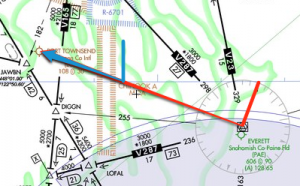How do I treat VOR courses on a nav log?
Here’s a question from Brandon, who’s working on cross country planning:
When you track a VOR and log the VOR heading, what do I log that as? I know you put it under Course (Route), but what is that called, Magnetic Course? If so, how do I get from Magnetic Course to Magnetic Heading, or are they the same thing?
There are a lot of different terms that we use when we plan flights: course & heading; magnetic course (MC); magnetic heading (MH); true course (TC); wind correction angle (WCA); the list goes on… but which goes where? The key is to remember the difference between plotting a course and flying a heading. In a no-wind situation, heading and course match. With wind, you still want to track the same course over the ground, and to do that you’ll need to crab your heading into the wind.

Getting back to the basics of your question, though, is what to call a VOR course. Whether you refer to it as your magnetic course, your outbound radial, or an OBS setting, it’s the same number. Charted airways are always depicted in terms of magnetic north. As shown above, your MC or OBS setting (red) differs, often significantly, from your TC (blue).
The second part of your question – how to get from MC to MH – is a little more complicated. Chances are, when navigating with a VOR or on an airway, you’ll be starting with a magnetic course. In the example above, we’d be flying from Paine Field to Port Townsend on the 270° radial, which gives us an MC of 270. Variation at the PAE VOR, set when it was constructed (thanks, Sarah, for reminding me of this!), is 20°E, which we add to get a TC of 290 – notice how much larger the blue angle is than the red one. Now you can go back and use your E6B to find your wind correction angle and true heading – but don’t forget, you now need to subtract variation to get what you need in the cockpit: magnetic heading.
Confused yet? It’s confusing stuff, and best explained one-on-one by your instructor with a series of examples. If you’re looking for additional study materials, it’s worth pulling out the manual for your E6B flight computer or checking out Gleim’s article on an alternate method for doing the math.


Sarah on Dec 18, 2008
I’ve had a cup of coffee ( and I Am _Not_ An Instructor ) so let me try.
First, there seems to be a confusion between “course” and “heading”. A heading is which way your head is pointed, and depending on wind, this can be quite different from the planned &/or actual track over the ground, the “course”. But you knew that. CFI’s recommendation on Gleim and your instructor are the right answer.
I always wondered why my carefully computed magnetic heading never seemed to match exactly the VOR bearing. My theory, maybe CFI has a comment, is that when VORs are “laid out” their bearings match local magnetic heading exactly. But magnetic variation changes slowly, and VOR charts don’t… so over time you can get quite far off before FAA steps in and redoes the VOR.
Hmmmm… our local airport used to have runways 29L and 29R. Now they are 30L and 30R ! Imagine all the work involved in moving those runways in the dark of night…
Eric on Dec 18, 2008
Sarah, you’re correct. VORs are set with the 360° radial pointed to magnetic north at the time they are constructed. While runways are relabeled over time, VORs don’t seem to be reconfigured unless they are moved or replaced.
A great way to see this in effect is to look at a sectional (or an IFR enroute chart) and note the difference between the 360° bearing arrow on various VORs.